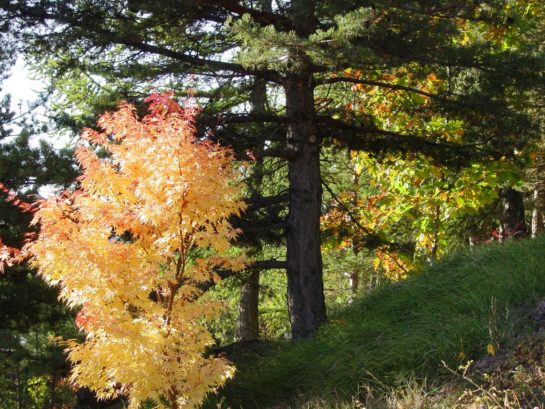Trees
A living museum
Each year, in November and March selon les espèces, l’Arboretum introduit de nouvelles essences sur son site. Au fil des années ce musée vivant de l’arbre s’est enrichi de nombreux feuillus et conifères qui font référence à l’étage montagnard.
Since its creation, more than 400 trees have been planted including 137 exotic species, successfully acclimatised.
A directory of spontaneous or introduced trees, shrubs and shrubs, produced by Dr Henri Sandoz and Dr Guy Aubert is available for download in the scientific committee section..
Also present spontaneously
Among others (including natural regenerations of woody species):
The White service tree or Mountain ash (Sorbus aria (L.) Crantz) and the Mountain ash (Sorbus aucuparia L.).
The Common Chestnut or Sweet Chestnut (Castanea sativa Mill.) whose chestnuts, especially rich in carbohydrates, constitute an
excellent food and whose wood offers multiple technological qualities. It can live up to 1000 years or more.
Downy oak (Quercus pubescens Willd.) and Sessile oak (Quercus petraea (Matt.) Liebl.).
Tall spruce ( (Picea abies (L.) Karsten = Picea excelsa (Lam.) Link) which can live 400-500 years and reach 50 m in height.
The Field Maple (Acer campestre L.), The Obier leaves Maple (Acer opalus Mill.), the Sycamore Maple (Acer pseudoplatanus L.).
Common Juniper or Juniper (Juniperus communis L.), Oxycedar Juniper or Cade (Juniperus oxycedrus L.) and Phoenicia juniper ( Phoenicia Juniper L.).
Cherry, Plum or Bird cherry (Prunus avium L. = Cerasus avium (L.) Moench).
The Royal Walnut or Common Walnut (Juglans regia L.).
The Silver fir or White fir (Abies alba Mill. = Abies pectinata (Lam.) DC.) which can reach 45-50 m in height and which can live 400, even 500 years.
The Broad-leaved Linden or Large-leaved Linden (Tilia platyphyllos Scop. = Tilia grandifolia Ehrh.) whose longevity can reach 1000 years.


